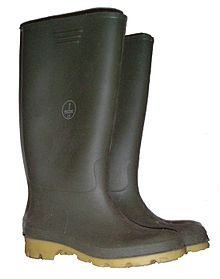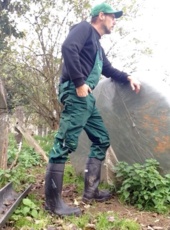rubber boots
Wellington boots (northern German also: galoshes or caloshes ) are calf to knee-high, waterproof boots with a relatively wide shaft tube, which are originally made of rubber , but are now also made of thermoplastics .
Demarcation
Rubber footwear in general does not count among the rubber boots. For example, rubber riding boots and waders still belong to the rubber boots from a shoe-technical point of view, but are generally referred to as riding boots or rubber riding boots, or waders and not as rubber boots. Waders and galoshes (overshoes made of rubber) are no longer rubber boots in terms of shoe technology either.
material

High-quality rubber boots are still made today from real natural rubber or rubber mixtures with a high proportion of rubber, since some rubber-specific material properties can only be achieved to a limited extent by plastics . Wellington boots based on natural rubber are (depending on the color) somewhat more susceptible to UV radiation and certain chemicals , but they do not change the essential properties of flexibility and toughness with normal temperature fluctuations . Overall, they are considerably more elastic than boots made of plastics (almost always PVC , rarely others, for example thermoplastic polyurethane ). High-quality rubber boots also offer soles made of other materials and other equipment details such as laces, pull-off aids, etc.
history
Already the original population of South America provided a primitive type of rubber boots forth by impregnating substances or footwear in the latex of the rubber tree ( natural rubber ). This resulted in a limited crosslinking of the latex substance and at the same time a certain durability was achieved.
In Europe, rubber-based waterproof boots (and other items of clothing) initially did not attract much interest. When it was very hot, the boots were too sticky and when it was cold they were brittle. Only when Charles Goodyear accidentally discovered in 1840 that plastic rubber, mixed with sulfur and soot and vulcanized by heating , becomes permanently elastic and no longer sticky, rubber products and thus rubber boots found their way into the market. Before z. B. the rural population largely rely on wooden shoes for their work on the farm and in the fields. From 1915 onwards, rubber boots were also in great demand among soldiers of the British Army during the trench warfare in Flanders (trenches in the rain).
The American Hiram Hutchinson acquired a license to manufacture rubber boots from Charles Goodyear. In 1853 he founded a factory for the manufacture of rubber boots in France, as he saw a good market in what was then predominantly rural Europe. He sold his product under the brand name A l'Aigle (eagle) as a tribute to the American heraldic animal. The Hutchinson company still exists today. The brand name was shortened to AIGLE over the years . The company, headquartered in France, still produces high-quality rubber boots for work and leisure.
Henry Lee Norris moved from America to Scotland in 1855, also with the aim of setting up a rubber boot factory. A year later, the North British Rubber Company started operations in Edinburgh. Around 100 years later, in the winter of 1955, the company presented what was then a new type of green rubber boot, which is now known as the Original Hunter Boot (Hunter is a purveyor to the British royal family).
In 1927, the Frenchman M. Claude Chamot also had the idea of producing rubber boots. He chose Le Chameau (the camel) as the brand name in reference to the nickname he had as a child. This company also produces high-quality rubber boots to this day.
At around the same time, other companies in Europe began manufacturing rubber boots, for example Phoenix AG in Hamburg and Semperit in Austria. Both companies still exist today, but have since stopped producing rubber boots and have specialized in technical rubber products for industry. The two most traditional German manufacturers of rubber boots include Elbit in Wittenberg and Romika with headquarters in Trier.
For decades, rubber boots were the preferred footwear in wet weather, as normal shoes were usually equipped with leather soles that soften slightly when it rains. In the 1980s, however, rubber boots in the leisure and sports sectors went out of fashion because they were replaced by waterproof shoes made with Gore-Tex and other synthetic materials. It was not until the late 1990s that rubber boots became fashionable again, initially through country fashion. After numerous celebrities appeared in rubber boots at various events in the early 2000s, they became a fashion accessory that was increasingly popular in the years 2005 to 2008. Numerous fashion labels currently offer colored and patterned models, especially for women.
Production of rubber boots
There are several methods in the production of waterproof boots:
Handcrafted production
The traditional production in manual work , the cut cloth-like natural rubber material is by hand on an aluminum afford applied and pressed. Then the rubber boot, which is made up of up to 35 individual parts, is vulcanized in a hot air oven at around 140 ° C. Due to the production by hand, it is also possible to use different types of rubber for the sole, insole, heel, reinforcements and upper material, which enables a high level of comfort. The most modern sports shoe technology can also be integrated into the rubber boot and fashionable and special anatomical requirements can be taken into account. Handcrafted rubber boots are often expensive.
Semi-automatic production
Another method is production in compression molds. A split mold is used, which presses the still soft rubber onto the strips and which is opened after vulcanization. The rubber boots made in this way can be recognized by the visible parting line of the shape, which is visible on the finished boot like a central seam. Wellington boots made in this way are inexpensive and yet robust and are mainly used as work boots.
Fully automated production
Plastic-based rubber boots are largely manufactured automatically by injection molding. Large numbers can be produced cheaply. The thermoplastic material is injected into the divisible mold while hot. After cooling, the finished boot is removed from the opened mold. These rubber boots also have a visible parting line.
application
Wellington boots are completely waterproof and have established themselves in many areas. As rain protection and fashion items they become professional - and casual clothing worn, especially where it comes to waterproof and easy to clean shoes.
Wellington boots as footwear in the wet season are also offered as fashionable shoes for women in appropriately colored designs. There are versions with heels of different heights, in different colors and styles , e.g. B. Western boots.
Outside of high mountains, rubber boots made of natural rubber are common footwear for hunters in Central and Northern Europe . These have also often found widespread use among dog and horse owners. Compared to PVC rubber boots, these are significantly more comfortable to wear. To enable year-round use, natural rubber boots are also available with a warming lining made of neoprene or Outlast .
In agriculture , especially in livestock farming , rubber boots made of polyurethane (PU boots) are used in particular because, unlike natural rubber boots, they are resistant to slurry over a long period of time .
maintenance
Wellington boots are extremely easy to care for. Coarse soiling is simply rinsed off with water and light soapy water. The surface is cared for with glycerine , which is added to the washing water or rubbed in undiluted. Glycerine protects the rubber from embrittlement. Silicone oil refreshes the surface and also prevents the premature aging of the rubber, which can be attributed to the effects of UV light and fatty substances from the biological environment. (For example, butcher's grease-resistant boots are made of neoprene .) Most brand manufacturers have special rubber care products on offer. Wellington boots are stored cleaned, dry, protected from light and cool.
literature
- Helge Sternke: Everything about men's shoes . Nicolai Verlag, Berlin, 2006, ISBN 3-89479-252-3 .
See also
- Waders
- Waders
- Shoes
- Wellington throw
- Arthur Wellesley, 1st Duke of Wellington , namesake of the " Wellingtons " (English name for rubber boots)
Web links
Individual evidence
- ↑ Hermann and Hans-Jürgen Fründt: Kauderwelsch, Plattdüütsch, the real North German. Reise Know-How Verlag, Bielefeld 1998, ISBN 3-89416-322-4 .
- ↑ Rubber for the feet , test of the Deutsche Jagd-Zeitung / Norbert Klups.




